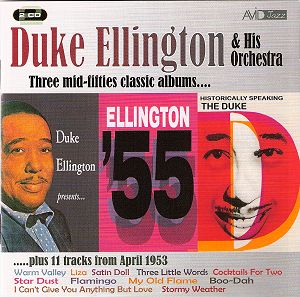CD1
Tracks 1-12: ‘Historically Speaking – The
Duke’
1. East St. Louis Toodle-oo
2. Creole Love Call
3. Stompy Jones
4. The Jeep Is Jumpin’
5. Jack The Bear
6. In A Mellotone
7. Ko-Ko
8. Midriff
9. Stomp, Look And Listen
10. Unbooted Character
11. Lonesome Lullaby
12. Upper Manhattan Medical Group
Tracks 13-22: ‘Duke Ellington Presents…’
13. Summertime
14. Laura
15. I Can’t Get Started
16. My Funny Valentine
17. Everything But You
18. Frustration
19. Cotton Tail
20. Day Dream
21. Deep Purple
22. Blues
CD2
1. Indian Summer
Tracks 2-8: ‘Ellington ‘55’
2. Rockin’ In Rhythm
3. Black And Tan Fantasy
4. Stompin’ At The Savoy
5. In The Mood
6. One O’Clock Jump
7. Honeysuckle Rose
8. Happy Go Lucky Local
9. Flying Home
Tracks 10-20: from April 1953 sessions
10. Warm Valley
11. Liza
12. Satin Doll
13. Three Little Words
14. Cocktails For Two
15. Star Dust
16. Flamingo
17. My Old Flame
18. Boo-Dah
19. I Can’t Give You Anything But Love
20. Stormy Weather
I had a good education. I
was brought up listening to my father's collection
of jazz on 78-rpm discs, including the likes
of Benny Goodman, George Shearing and, naturally,
Duke Ellington. Ellington's livelier works
appealed to me greatly - such as Cotton
Tail with its unforgettable Ben Webster
solo and Sonny Greer driving the rhythm along
like an express train. But I was exposed to
a later version of the Ellington band when
I accompanied a school friend into a record
shop where we listened to an LP called Ellington
'55. My friend bought it and I was knocked
out by its dynamism.
The 1950s were not a good
time for Duke Ellington. Three key musicians
- Johnny Hodges, Lawrence Brown and Sonny
Greer - left the band early in 1951, although
Hodges returned in 1955 and Brown in 1960.
And the early fifties was a difficult period
for big bands, which tended to be replaced
by small groups. Ellington kept his orchestra
together but there was a sense among some
critics that he was treading water. Much of
the music on this double CD consists of refashioned
versions of old Ellington compositions, jazz
standards, or interpretations of other big
bands' successes.
So the first album in this
collection, Historically Speaking - The
Duke (from February 1956) presents new
arrangements of a dozen Ellington favourites
- in chronological order from East St Louis
Toodle-Oo (1926) to Upper Manhattan
Medical Group (1954). The latter is credited
as an Ellington composition on the sleeve,
but it was written by Billy Strayhorn. Note
the precision of the saxes on Midriff
and the cohesion of the whole ensemble in
Stomp, Look and Listen.
Even though these first twelve
tracks tread old ground, they still sound
fresh. For instance, Johnny Hodges adds some
beautiful obbligato at the end of Creole
Love Call, while Jack the Bear
(originally a feature for bassist Jimmy Blanton)
is refreshed with some clear clarinet from
Jimmy Hamilton and jaunty baritone sax from
Harry Carney. However, the version of Ko-Ko
can't match the classic original, especially
as it is here speeded up to an uncomfortably
fast tempo which loses some of the original's
mystery.
The album Duke Ellington
Presents was recorded at the same February
1956 session that produced Historically
Speaking. It turns the spotlight on the
individual musicians in a mixture of jazz
standards and Ellington originals. Paul Gonsalves
solos tenderly on Laura; Ray Nance
illustrates two of his many talents by singing
and playing violin in I Can't Get Started;
and Johnny Hodges' alto is as moving as ever
in Day Dream.
Ellington '55 is a
strange but captivating mixture. Besides three
Ellington originals, there are tributes to
several other big bands. One O'Clock Jump
pays homage to Count Basie by imitating the
Basie arrangement, while Stompin' at the
Savoy recognises both Chick Webb and Benny
Goodman's versions of the tune. Strangest
of all is In the Mood - probably a
nod to Glenn Miller but not a tune one would
naturally associate with the Duke. Ellington's
piano introduction is typical Duke but, when
the orchestra comes in, it sounds like a conventional
big band. Thankfully solos from Clark Terry,
Jimmy Hamilton and (probably) Russell Procope
retrieve the band's reputation for originality.
Happy Go Lucky Local reflects Ellington's
love for locomotives (and wasn't it later
stolen to make Night Train?).
When the Ellington '55
album was re-released as a CD in 1999,
it contained two bonus tracks - Body and
Soul and It Don't Mean a Thing (If
It Ain't Got That Swing). Sadly these
are omitted from this reissue: instead we
get eleven tracks from April 1953. These include
the first-ever recording of Satin Doll
(happily without those incomprehensibly hip
lyrics); some fine piano from Duke Ellington
in Flamingo; and a neat solo by Clark
Terry on Boo-Dah.
Although some tracks here
suggest that Ellington was having a struggle
to keep his band together, and sometimes resorted
to making recordings that might have "commercial"
appeal, his orchestra was still unique. Thankfully
the band's performance at the 1956 Newport
Jazz Festival revived Duke's fortunes, rescuing
him from the early fifties' doldrums. And,
because this double CD comes at Avid's usual
startlingly generous price, it is well worth
buying.
Tony Augarde
